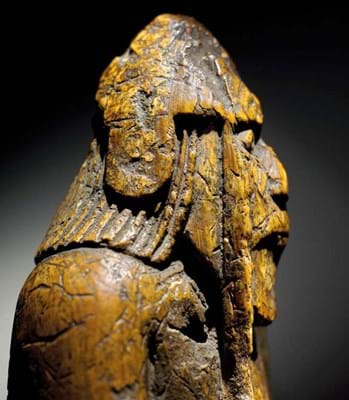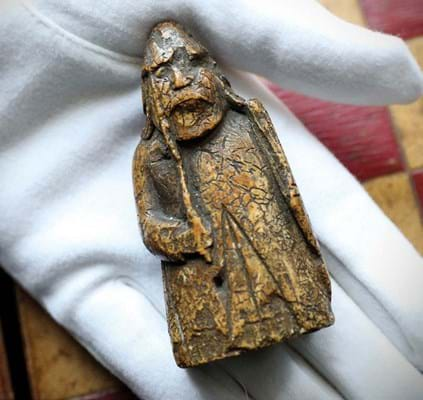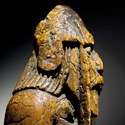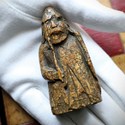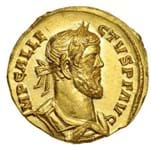The figure of a warder (or rook) was bought in 1964 in Edinburgh for £5 by an antiques dealer and had been stored in a drawer for decades. The family of the dealer has consigned it to Sotheby’s July 2 Old Master Sculpture & Works of Art sale in London with an estimate of £600,000-1m.
Mystery surrounds the exact details of how, and by whom, the hoard was found in the Isle of Lewis, the westernmost of the Outer Hebrides, in c.1831.
The elements changed hands a number of times before the British Museum secured 81 pieces at a cost of 80 guineas with 11 extra objects later acquired by the National Museum of Scotland, Edinburgh. The museums hold eight kings, eight queens, 16 bishops, 15 knights and 12 warders, 19 pawns and 14 flat, circular games pieces (tabula) and one buckle to secure the bag – a total of 93 walrus ivory objects.
The pieces are generally thought to be Norwegian, probably made in the ivory carving centre of Trondheim. Trondheim was the seat of the archbishop of Norway, with the island of Lewis under its authority as part of the kingdom of Norway from early Viking times up to the Treaty of Perth in 1266.
‘Five missing pieces’
Sotheby’s, with the assistance of experts including Prof Neil Stratford, former keeper of medieval and later antiquities at the British Museum, believe there are five missing pieces from the hoard that would allow for the completion of several chess sets.
A popular theory is that the hoard was buried on Lewis by a medieval trader after a shipwreck.
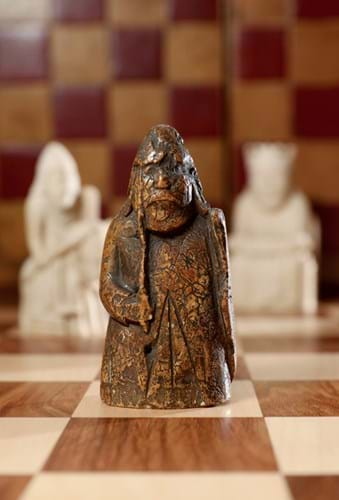
This warder, thought to be from the Lewis Chessmen hoard, will be offered with an estimate of £600,000-1m at Sotheby’s London on July 2.
In its catalogue note, Sotheby’s said: “Based upon a close visual comparative study with the extant chessmen in UK public collections, and in consideration of views expressed by leading academics in the field of medieval ivories… we propose that there is a strong case that the present warder probably formed part of the Lewis hoard itself.”
It adds that there are “clear parallels… accepting the point that all the pieces have differences from each other… The present warder is the only known chessman of the Lewis type which has not been cleaned and this clearly sets it apart from those in the hoard.
“It is a logical deduction that the present warder could be one of the lost pieces… However, in the absence of a recorded find site… there is and will continue to be healthy scholarly debate on this subject.”
Alexander Kader, Sotheby’s co-worldwide head of European sculpture and works of art, said: “There is certainly more to the story of this warder still to be told, about his life over the last 188 years since he was separated from his fellow chessmen.”
Inheritance
A spokesperson for the family that has consigned the piece said: “My grandfather was an antiques dealer based in Edinburgh, and in 1964 he purchased an ivory chessman from another Edinburgh dealer. It was catalogued in his purchase ledger that he had bought an ‘Antique Walrus Tusk Warrior Chessman’.
“From this description it can be assumed that he was unaware he had purchased an important historic artefact. It was stored away in his home and then when my grandfather died my mother inherited the chess piece… For many years it resided in a drawer in her home where it had been carefully wrapped in a small bag.”
Symbol of civilisation
The collection is regarded as a symbol of medieval European civilisation and was included by Neil Macgregor, former director of the British Museum, in his BBC Radio 4 series, A History of the World in 100 Objects. He said that ‘if we want to visualise European society around the year 1200, we could hardly do better than look at how they play chess. And no chess pieces offer richer insights than the… Lewis Chessmen.”


